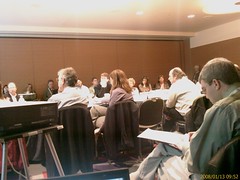This article is more than 5 years old.
I started off the day bright and early, attending the Top Technology Trends committee meeting. It was different than the one I went to a year earlier. Since it is Midwinter, it was more informal, with the technology gurus seated around a table having an informal discussion about technology trends. Those of us who went to observe sat in chairs around the edge of the room. Since not all committee members were able to be here, a valiant attempt was made to connect one member virtually via Skype. It didn’t work seamlessly, but it was a nice touch since, after all, it was a technology session with a room full of geeks. What struck me was that instead of hearing much talk about far out “new” potential technologies, the greatest portion of the 2 hours was spent discussing topics we are all grappling with: liability and security concerns regarding storing documents remotely (ie on Goggle servers), implications for equipment and services when the Web becomes the operating system and the application server, and why our organizations are so far behind in providing adequate server space for their constituents when Goggle will give gigs away for free. A most interesting exchange concerned the difficulty these folks are having at their home institutions getting their IT units to provide locally housed and controlled wiki and blog space (Yea, ZSR for being ahead of this trend!)
Two interesting concepts that Karen Schneider discussed were the “architecture of participation” and the “architecture of aesthetics.” The first refers to the whole Library 2.0 movement of user involvement and empowerment and how many commercial vendors (ie Library Thing) get it, when major library vendors (OCLC was mentioned) still don’t. The architecture of aesthetics is her way of describing that users are making it known, in many different ways, that aesthetics count. Of course, the most current example of this is the IPhone. That sparked a discussion of ebooks and their aesthetics and functionality. And, Erik will be thrilled to hear this, a big discussion took place about what Erik coined “federated services.” (No, Erik they called it “seamless fulfillment”, but they were talking about exactly what you recognized a need for 2 years ago: the technology and interface that allows a user to request some service or item in a single place without him having to know at all what will take place behind the scenes to fulfill his needs). Other familiar topics included copyright, digital storage, preservation storage, the coming of age of open source and what users want from libraries! Finally, in the last 10 minutes they did a lightening round where some hot new trends were mentioned oh so briefly: location awareness, cloud computing, green computing and surface computing. Hopefully, these are discussed in more depth in the LITA blog where the trends are posted.

